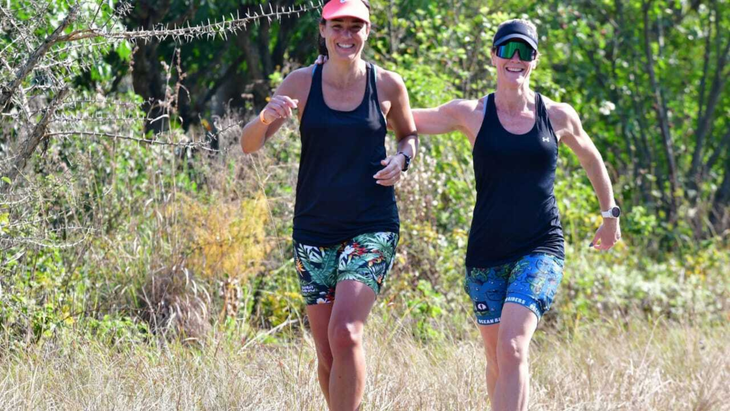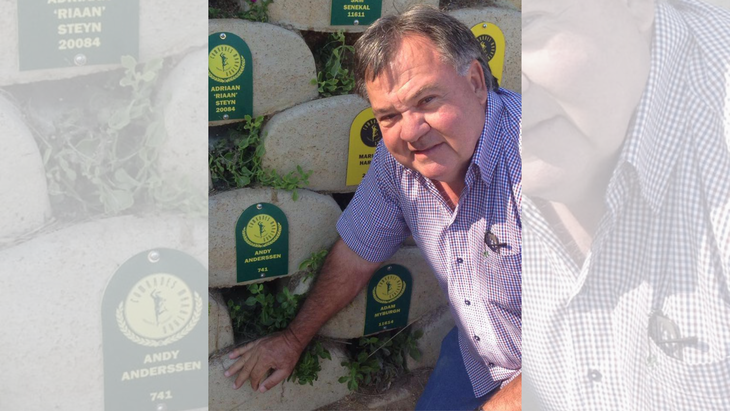Products You May Like
Get access to everything we publish when you
sign up for Outside+.
Pam Payne knows pain. Forty-five kilometers into the 2018 Comrades Marathon, the 47 year-old mother of four collapsed onto the tarmac. Her body ached so badly that she considered dropping out. Instead, Pam picked herself back up and ran, walked, and hobbled the remaining 44 kilometers, finishing the storied 89-kilometer (55-mile) foot race for the fifth consecutive year.
The soreness from that fall stubbornly stuck around, even several months later. “I’d try and run 5ks and I thought I was OK,” Pam says. “But then later on, I’d be so sore. I think we think we are indestructible. I mean, how can just a fall do such damage?”
A visit to the doctor revealed that fall had indeed done a lot of damage—she cracked her pelvis down the middle and tore most of the surrounding muscles.
“I’ve got a very high pain threshold,” the compliance officer and Durban, South Africa, resident says. “So I pushed through the pain. And that’s why I ended up collapsing. I’ve managed to do quite a lot of damage to myself purely because I haven’t known where that switch is. When I was little, I always used to stub my toe and do a whole lot of things I didn’t realize. And the more you block those pain receptors when you are younger, the more you can take when you’re older.”
The highs and lows of Pam’s high pain tolerance have largely defined her running career. Despite finding distance running relatively later in life, she’s dealt with far more than her share of pelvic stress injuries. Four? Five? It’s easy to lose count. Sadly, pelvic floor-related issues affect post-partum runners far too frequently. Over a third of new mothers experience pain in the pelvic region. And nearly the same percentage report abdominal separation, known as diastasis recti, according to a 2017 Sports Health study of over 500 postpartum runners.
In Pam’s case, she didn’t even really start running until after giving birth—four times. Yet, her entrée into ultrarunning was foreshadowed decades before. Andy Anderssen, Pam’s father, ran Comrades 13 times.
“When I was a little girl, I always said to my dad ‘one day I’m gonna run it with you,” Pam says. “I never got the opportunity to do that. But I always thought it was something I should do.”
Andy encouraged all three of his kids to run while they were growing up in Johannesburg, South Africa. Pam joined the track team, where she ran the 100- and 200-meter dash events. Andy bought Pam her first pair of running shoes, and he helped out with her training. By Pam’s early teens, the allure of falling in her father’s footsteps wore off. Hanging with friends sounded more appealing.

Getting Started
After earning her bachelor’s degree in commerce and later a law degree, Pam took a job in compliance for JP Morgan in the UK. There, she occasionally hit up the treadmill to blow off steam. But Pam doesn’t consider the birth of her distance running career until 2009, after giving birth to her four children in four and a half years.
“I just needed some time for me. I was going to the gym, but my body sort of thought all it was meant to do was be pregnant or breastfeed,” Pam says. “So the doctor said, ‘why don’t you try something different?’ So I decided to start running.”
Twenty-minute run-walks after dropping the older kids off at school quickly progressed. Pam found training partners and signed up for her first race. She ran the Royal Parks Half Marathon “very slow,” she says, “But I enjoyed it.” Pam ramped up her training more, and raced Royal Parks faster the following year.
With two half marathons under her belt, it was time to report her half marathon PR to her dad. Andy had stopped running by then due to health issues, but according to Pam his standards remained the same: “He was like, ‘I never ran half marathons. I only ran full marathons. And his time was not much more than my half marathon time.”
There was only one way to make Andy proud. Pam acquired a charity bib to run the London Marathon. But during the buildup, she developed a stress fracture in her pelvis. Pam’s doctor attributes the injury to her four natural births, followed by no post-partum rehab. After what felt like a judicious and thorough recovery, Pam’s pelvis broke again.
Discovering The Comrades Marathon
In January 2014, Pam and her family moved back to South Africa, where she slowly started building back up her running in her continued quest to run London. But running is a religion in Durban, Pam’s hometown and, depending on the year, the start or finish of Comrades. In the U.S., telling most people you’ve completed a marathon fills them with awe. Not so in this eastern South African coastal city.
“If you live in Durban and you say you run, the next question is, ‘Have you done Comrades?’ And if you say ‘yes,’ then they want to know ‘What’s your marathon time? What’s your Comrades time?” Pam says. “It sounds bad, but it’s almost like you can’t classify yourself as a real runner in Durban until you’ve run Comrades.”
Comrades is the birth child of World War I South African veteran Vic Clapham, who wanted to commemorate South African soldiers lost during the war. Clapham had served in the East African campaign, a series of battles and guerilla warfare that involved marching 1,678 miles (2,700-kilometers) across the oppressively sticky and suffocating terrain of German East Africa. Clapham wished for the memorial to celebrate this spirit over adversity. A stone, stationary statue would not do.
Now, 101 years after its inception, Comrades still rings true to Clapham’s vision. To celebrate humankind’s spirit over adversity, runners must first overcome, well, a lot of adversity. For one, there’s the relentlessly rippling terrain. There’s also pounding your ligaments, tendons, and bones into the pavement for 55 miles, and the Florida-level thick, stifling air along the coast. Unlike most road races where your chip time starts when you cross the start line, at Comrades, your chip time starts when the gun goes off. So if you’re in the final wave, batch H, of the 25,000-person race, you have about 9 or so fewer minutes to make the 12-hour cutoff.
Given the esteem Comrades holds in South African running circles, running groups abound in Durban and one swept Pam up. She and her training partners ran at 5 a.m. most weekdays to beat the oppressive heat and humidity, as well to come home in time to shepherd the kids to school.
During that build up for London, Pam ended up running a marathon in training, inadvertently qualifying for Comrades in the process. How could she turn down the opportunity to follow in her father’s footsteps and make him proud?
“My dad thought I was a bit mad.”
Pam raced the 2014 Comrades Marathon anyway. After all, it runs in the family.

Ups and Downs Along The Comrades Marathon Course
The Comrades Marathon course follows a point-to-point line between Durban and Pietermaritzburg. The direction of the race flip-flops each year between the “up” run starting in Durban and the “down” run starting in Pietermaritzburg.
Swept up in the excitement of training for Comrades 2015, Pam overlooked post-race recovery and downtime. Plus, doing the “extra” work like strength, flexibility, and rehab can feel like a luxury when you have a busy life. “I don’t think any of us really take proper time out,” she says. “And I think when you’re busy with work or children or whatever, we don’t often take time for ourselves.” Niggles flared up like prairie dogs on the plains. At some point, Pam realized her abs were torn.
Here’s the catch about Comrades. Because of the two unique courses, Comrades participants are newbies not once but twice. “I got stuck on that,” Pam says. She recovered enough from her torn abs and injuries to race the “up” course in 2015. After graduating from newbie status, Pam set her eyes on the next big Comrades goal. Runners who finish Comrades 10 times join the Green Number Club, meaning they earn a permanent green bib.
If a green bib is the carrot, the spirit of the race is the sauce that envelopes the runner’s senses and hooks them to the self-inflicted punishment of repeating a 55-mile road race year after year.
“It’s about the camaraderie and the friendships. They call it the ultimate human race, and you only get a real feel for the race when you actually run it,” she explains. “What’s nice about running is that everyone’s on the same level. Doesn’t matter whether you are the CEO of a company or if you clean the streets. It’s the same for everyone, you’re all going for a common goal. Yes, some people want gold. Some people just want to finish. But you’re all working towards a common goal.”
Despite her injuries, Pam crossed the finish line at Comrades for five consecutive years. Her key to consistency lies in her mindset. “I’m running for me. I’m not running for what time you think is a good time,” Pam says. “I call myself a bit of a car. I’m just slow and steady and I just keep going at it.”
Indeed, Pam’s performances have been remarkably steady, with her times ranging from 9:49:55 (a “down” year) to 10:48 (her first “up” year)—less than a 10 percent variance.
After cracking her pelvis during the 2018 Comrades, doctors told her she should probably stick with 10ks and below. Pam thinks that fall and the associated damage can be traced back to her postpartum injuries—“lovely lady issues,” Pam says. Still in pain the following spring, Pam had no choice but to withdraw from the 2019 race.
Breaking her Comrades streak motivated Pam to try and break the injury cycle. She started doing strength work twice a week, fitting in physio appointments, and even a massage or two.
On August 28, Pam will toe the line at Comrades for the sixth time. This one will be special. For one, it will be Pam’s first opportunity to race Comrades since that fateful 2018 race. Comrades has not been held since 2019, before the COVID 19 pandemic engulfed the globe. This year’s race means redemption. It also means remembrance.
“This year I am running in memory of my dad, who passed away last year from cancer,” Pam says.
For the sixth time, Pam will race in green bib 741—her father’s permanent green bib which he gifted to her—as she continues her journey to join him in the club herself.
